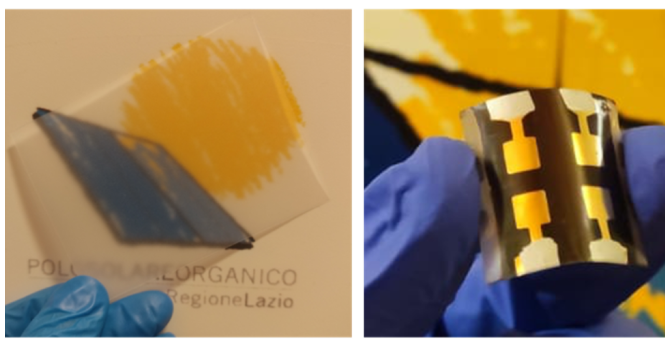一个国际研究小组展示了首款基于聚碳酸酯基板的钙钛矿太阳能电池,适用于柔性光伏应用。
该小组采用工业兼容的制造方法,生产出功率转换效率为 13.0% 的器件,在半径为20毫米的弯曲循环 1000 次后,其功率转换效率仍可保持 87%。
纯聚碳酸酯薄膜(左)在聚碳酸酯薄膜上制作的四个柔性钙钛矿太阳能电池(右)
图片:罗马第二大学 CHOSE(混合和有机太阳能中心)
一个国际研究小组展示了一种在聚碳酸酯基板上制造钙钛矿太阳能电池的方法,该方法与柔性光伏设备的工业生产工艺兼容。
该研究的第一作者 Zeynab Skafi 告诉《光伏》杂志: “我们通过开发一种刀片涂层的平坦化层,在聚碳酸酯薄膜上开发出了有史以来第一款钙钛矿太阳能电池,其电力转换效率为 13.0%,同时还提供了必要的耐溶剂性。”
测试表明,在半径为20毫米的弯曲循环1000次后,仍能保持87%的效率。“暗存储(ISOS-D-1)和热稳定性(ISOS-T-1)测试显示 T 80值分别为1776小时和 144小时,”该小组解释道。
它还指出,这些值最终可以通过应用超高渗透屏障得到改善,因为早期的研究表明它们可以将水蒸气透过率降低三个数量级。
研究团队指出,聚碳酸酯因其玻璃化转变温度相对较高、吸湿性较低,相较于聚对苯二甲酸乙二酯(PET)和聚萘二甲酸乙二酯(PEN)等其他柔性基材具有优势,并强调其在可见光谱中具有 90% 的“优异透明度”,与 PET 和 PEN 的 90% 和 88.7% 相当。
文章还补充道,尽管聚碳酸酯具有重量轻、柔韧性好、成本低等优点,但此前从未用于此类应用。通讯作者 Thomas M. Brown 告诉《光伏》杂志:“尽管聚碳酸酯的市场规模巨大,与 PET 相差无几,但比 PEN 大得多,但迄今为止,由于其耐溶剂性差和表面粗糙度高,聚碳酸酯从未用于此类用途。”
该团队采用刮涂法涂抹一层商用常温固化耐火树脂的平坦化层,解决了粗糙度和耐溶剂性难题。
据报道,此步骤将“表面粗糙度从 1.46 µm 降低到 23 nm,并将水蒸气透过率降低了一半,从而“显著提高”了耐溶剂性,使前体墨水能够沉积。
实验中,钙钛矿太阳能电池的制备如下:由聚碳酸酯和氧化铟锡(ITO)制成的基板、氧化锡(SnO 2)电子传输层、钙钛矿层、基于Spiro-MeOTAD的空穴传输层和金(Au)触点。通过控制透射率、方块电阻、表面粗糙度来优化ITO层,除两个电极外的所有层均在100 C以下的低温下进行溶液处理。
该团队强调,该制造工艺“兼容低成本制造”,并能够与其他印刷电子元件集成。
研究人员得出结论,将钙钛矿电池与聚碳酸酯薄膜相结合,可以在各种室内和室外应用中整合光收集功能。布朗说:“向新的基板材料开放柔性太阳能电池市场,可以在未来的能量收集、为未来的电子设备供电以及智能窗户、天窗、建筑、智能数字和身份证等快速增长的市场中发挥重要作用。”
研究结果详见《先进能源材料》杂志发表的《Flexible Perovskite Solar Cells on Polycarbonate Film Substrates》。
该研究小组包括来自意大利第二大学 CHOSE(混合和有机太阳能中心)、ENEA 弗拉斯卡蒂研究中心、Halocell Europe 和 Istituto di Struttura della Materia 的研究人员,以及来自德国弗劳恩霍夫有机电子、电子束和等离子体技术研究所(FEP)和伊朗吉兰大学的科学家。
原文链接:https://www.pv-magazine.com/2024/09/26/flexible-perovskite-solar-cell-based-on-polycarbonate-substrates-achieves-13-0-efficiency/
钙钛矿太阳能电池能否战胜强大的晶硅,仍需要时间进行验证。设备方面,镀膜设备、涂布设备、激光设备、封装设备为钙钛矿电池制备四大设备,欢迎大家加入艾邦钙钛矿产业链上下游交流群。
钙钛矿光伏进展到底如何?从上海光伏展相关组件展示略窥一二
An international research group demonstrated a method to fabricate perovskite solar cells on polycarbonate substrates that is compatible with industrial production processes for flexible PV devices.
“Here we developed the first ever perovskite solar cell on polycarbonate films with a power conversion efficiency of 13.0% by developing a blade-coated planarization layer that also provided the necessary solvent resistance,” Zeynab Skafi, the study’s first author, told pv magazine.
Testing indicated that 87% of efficiency is maintained after 1000 bending cycles at a radius of 20 mm. “Dark storage (ISOS-D-1) and thermal stability (ISOS-T-1) tests showed T80 values of 1776 h and 144 h, respectively,” the group explained.
It also noted that these values could eventually be improved by applying ultra-high permeation barriers as they have been shown in earlier research to lower water vapor transmission rates by three orders of magnitude.
Pointing out that polycarbonate has advantages over other flexible substrates, such as polyethylene terephthalate (PET) and polyethylene naphthalate (PEN), due to its relatively high glass transition temperature, and low moisture absorption, the team stressed that it has “excellent transparency” of 90% in the visible spectrum, which is comparable to PET and PEN with 90% and 88.7%, respectively.
It added that the polycarbonate had not been used before for this kind of application despite other advantages, such as being lightweight, flexible, and low cost. “Up to now, polycarbonate has never been used for this purpose even though it has a huge market, not far off from that of PET and much bigger than that of PEN, due to its poor solvent resistance and high surface roughness,” corresponding author Thomas M. Brown told pv magazine.
The team solved roughness and solvent resistance challenges by using a blade coating method to apply a planarizing layer of commercial ambient-curable refractory resin.
The step reportedly reduced “surface roughness from 1.46 µm to 23 nm, and cut the water vapor transmission rate in half, which “significantly improved” solvent resistance enabling deposition of precursor inks.
In the experiment, the perovskite solar cells were fabricated as follows: a substrate made of polycarbonate and indium tin oxide (ITO), a tin oxide (SnO2) electron transport layer, a perovskite layer, a hole transport layer based on Spiro-MeOTAD and gold (Au) contacts. The ITO layer was optimized by controlling transmittance, sheet resistance, surface roughness, and all the layers, except the two electrodes, which were solution-processed at low temperatures below 100 C.
The team stressed that the fabrication process is “compatible with low-cost manufacturing” and enables integration with other printed electronic components.
The researchers concluded that combining perovskite cells with polycarbonate films enables the integration of light-harvesting capabilities across a wide range of indoor and outdoor applications. “Opening up the market of flexible solar cells to new substrate materials can play a significant role in the future for energy harvesting, powering future electronic devices, and contributing to rapidly growing markets like smart windows, skylights, buildings, smart digital and ID cards,” said Brown.
The results are detailed in “Flexible Perovskite Solar Cells on Polycarbonate Film Substrates,” published in Advanced Energy Materials.
The research group included Italy-based researchers from CHOSE (Centre for Hybrid and Organic Solar Energy) Tor Vergata University, ENEA Frascati Research Center, Halocell Europe and Istituto di Struttura della Materia, along with scientists from Germany’s Fraunhofer Institute for Organic Electronics, Electron Beam and Plasma Technology (FEP), and the University of Guilan in Iran.
原文始发于微信公众号(艾邦光伏网):首款基于聚碳酸酯基板的柔性钙钛矿太阳能电池,效率达13.0%





